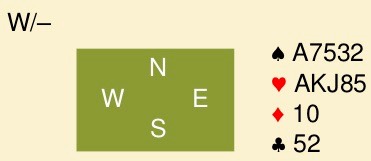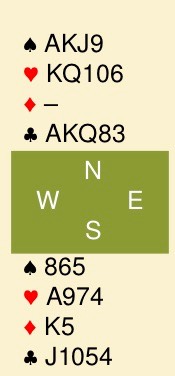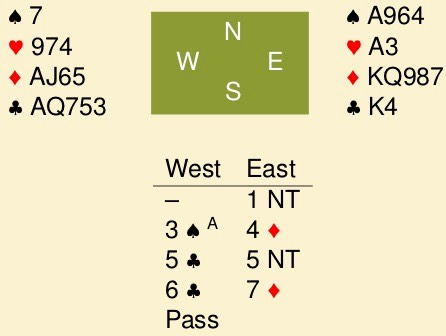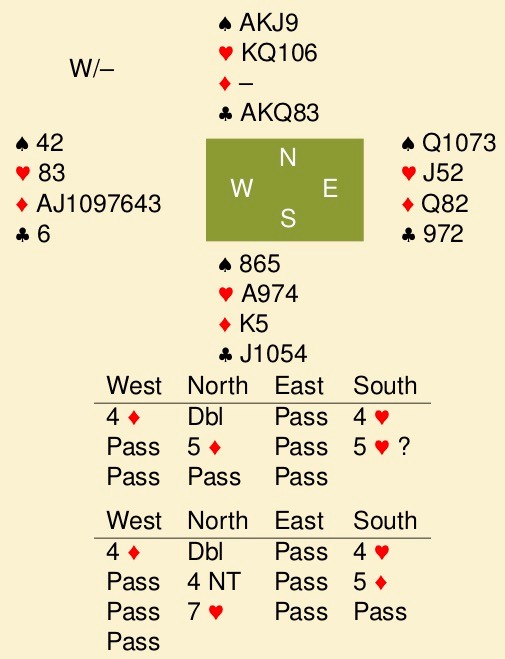Teams, first hand of the session, you pick up:

1♣ by partner (natural, or 11-14 balanced), 1♠, 1NT, 2♣ checkback, 2♥ showing 4♥. Your bid?

A couple of boards later… with nobody vulnerable, west opens 4♦, partner doubles and with no further bidding from the opposition, you reach 7♥ as south. West leads the ♣6. Plan the play.

Take a look at this hand from the recent Camrose Trophy. The Camrose is an annual match between the national teams from England, Scotland, Ireland, Northern Ireland and Wales. Nobody vulnerable and the first question is whether you want to be in 7♦ or not. The second one is, of course, how to bid it.
But let’s look at the first question first. The author of the daily bulletin calls it a good grand slam, making whenever the clubs split 3-3 or the diamonds 2-2. Diamonds 2-2 is about 40.7%, clubs 3-3 about 35.4%. Combine the two and you end up with a probability of making of about 62%: 40.7% plus 35.4% of the (100-40.7)% of the cases when diamonds are 3-1. Should this grand slam be bid?
At first, this looks simple: 7♦ scores 1440, 6♦ with an overtrick 940, so the gain for bidding slam when it makes is 500, or 11 imp's. Going down, you lose 50 compared to 920, or 14 imp's away. That means that you should make the contract at least 14 out of 25 cases, or 56%. 62% is greater than 56% so the answer is yes, bid it.
However, it is not as simple as that. This calculation assumes that the other table will bid 6_ all the time and that is definitely not correct as bidding this slam strongly depends how this hand fits into the methods of whoever has the hand. If the opponents bid only 5♦ (or any other game) bidding 6♦ will show a 500 point, or 11 imp, gain whenever there are 12 or 13 tricks. Bidding 7♦ gains 14 imp’s when there are 13 tricks, but loses 10 when there are only 12. In other words, the gain is only 3 and you should make the contract in 10 out of 13 cases, or some 77%. Now slam suddenly becomes an underdog. In the event, slam was missed 4 out of 6 times, and 7♦ would have gone down when both clubs and diamonds failed to behave.
This calculation did not take into account that the final contract might get doubled, or that one will occasionally go down 2 in an attempt to make the contract, the vulnerability or slams bid in a major. If you take that into account, the rule of thumb is roughly: if you are certain that the other side will be in slam, bid a grand if you expect it to make in at least 60% of the cases, if you are not certain, only bid a grand if you expect to make it in at least 80% of the cases.
Or, as some NPC’s have said in the past: anytime you bid a grand slam, go down, with the opponents staying in game, you will be charged €50 to buy your teammates a round of drinks. As for the auction to 7♦, here is a suggestion: 1 NT 15-17, 3♠ showing 1♠, 3♥ and 45 in the minors. 4♦ to set trumps, 5♣ cuebid, and a grand slam force.

Having to fork out €50 will make you think twice about bidding marginal slams and if you do, about the best line of play. With that in mind, take a look at problem 1, a hand from the local team competition last week.
Yes, I can see a layout where this makes 7♥: ♠Kx, ♥xxxx, plus ♦A and ♣AK or similar. But even when partner has this perfect hand, you still have to pick up hearts for no losers and the spades have to behave as well. Partner did have the perfect hand, but ♥Qxx was offside for down 1. And, at the other table, the player in your chair bid a somewhat lazy 4♥ over 2♥, ending the auction. 6♥ making would have won 11, 7♥, down 1 costs 11. Note that none of the 7 other players who held the east cards, bid anything more than 4♥.
And then there was this hand in the same match:

West started proceedings with a 4♦ preempt and that immediately caused a few problems for NS. As south, take a sure plus by passing or try 4♥ hoping for a playable fit? What what if north doubled on, say, 4-3-1-5 shape? And over to north: do you pass 4♥ or bid on. And if you bid on, what do you bid? Finally, what should south do when north asks him for his opinion.
At our teammates’ table, south bid a simple 4♥ over the double, then found himself endplayed over 5♦. Yes, you have extra’s but no convenient way to show them, +480 but nothing to be proud of.
Our opponents came up with a creative 4NT asking for keycards and then a raise to 7_, gambling that the 1 keycard was the ♥A. I admit that this didn’t cross my mind but it worked out nicely.
Now the play on the ♣6 lead, with east contributing the ♣9. EW use standard carding, if you decide to believe their spot cards that is.
Without any bidding from the opponents, the hand is fairly straightforward: win in hand, ruff a diamond, draw trumps, take a spade finesse and hope for the best. But after the 4♦ opening, that is not likely to work. There is an alternative though: win in hand, ruff a diamond with the ♥10, play the ♥6 to the ♥9, ruff a second diamond with a high trump, cross to the hand in clubs, draw trumps and claim, as the full hand was as shown on the side.
Dangerous? Well, you have taken a heart finesse through east, instead of a spade finesse through west. The preempt suggest shortness in the majors with west, so the heart finesse is far more likely to work than the spade finesse. The second line requires clubs to be 2-2, or 3-1. In the latter case, the player with the singleton club may not have 3 hearts. As opener presumably has the short clubs, that means that his shape must be something like 2-2-8-1, which is not unlikely.
Fortunately for us, declarer missed this at the table. We were happy with 2 times 11 imp’s, on our way to an 18-2 victory.
